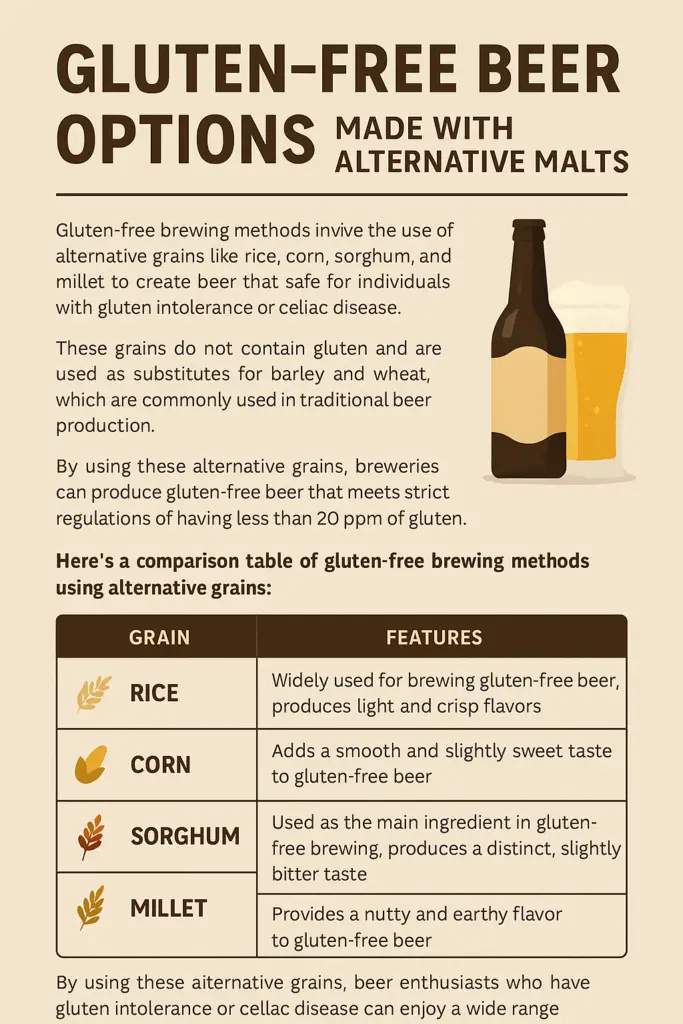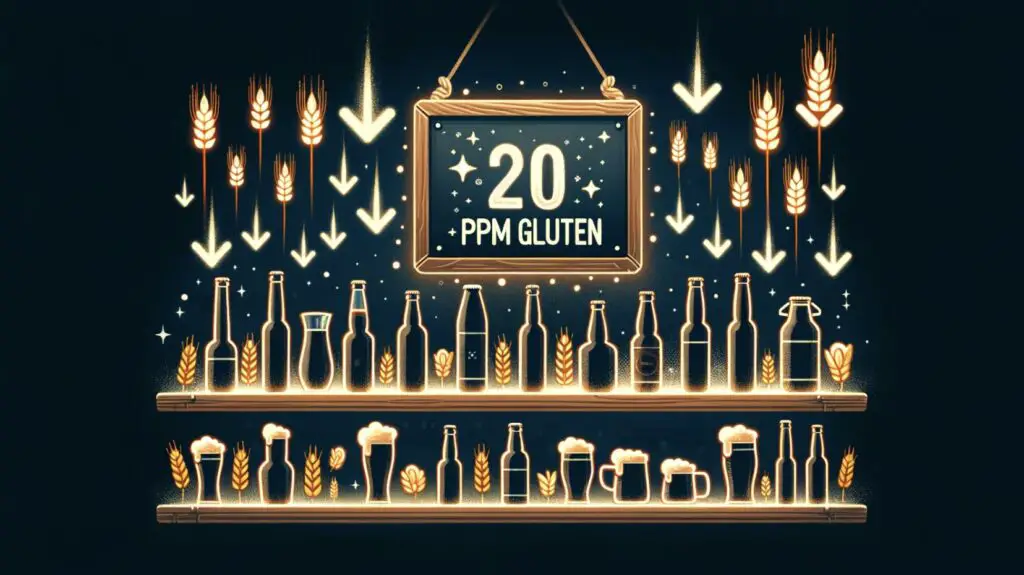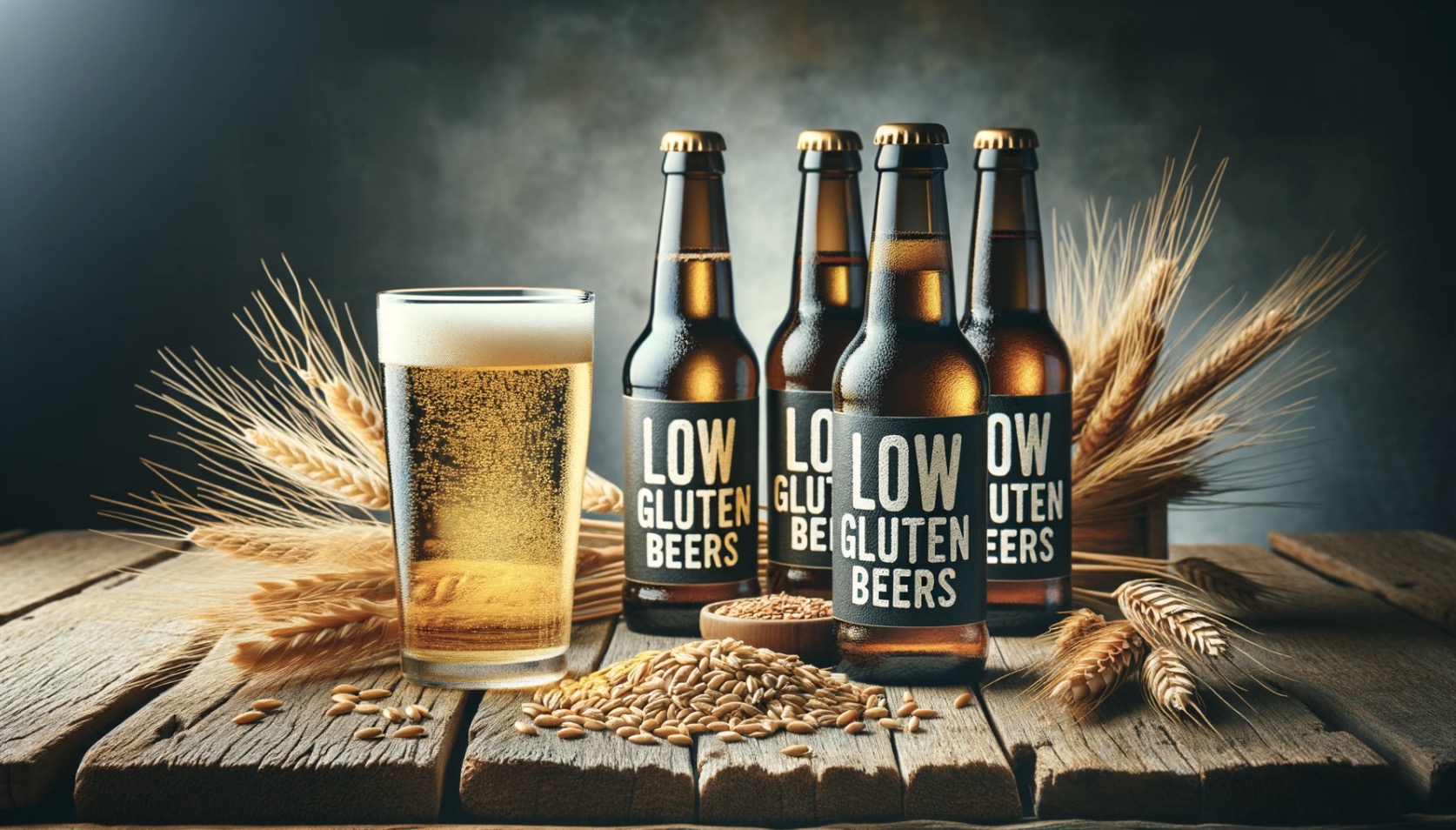There are several beers available on the market that have less than 20 ppm gluten, making them suitable for individuals with gluten sensitivities or celiac disease.
Most of these are enzymatically treated or made from alternative grains such as millet, sorghum or rice.
But some “ordinary” pilsners e.g. those from Coors, Budweiser, Bush and Carlsberg contain less than 20 ppm gluten due to their brewing process and high level of filtration.
These beers typically fall into two categories: gluten-removed and gluten-free. In this blog post, we will discuss the differences between these two types of beers, some popular examples, and additional factors to consider when choosing a low-gluten beer.
What beers have less than 20 ppm gluten?
There are several beers available in the market that have been specially crafted to have less than 20 parts per million (ppm) of gluten, making them suitable for individuals with gluten sensitivities or celiac disease. Here are a few examples:
1. Gluten-removed Beers: Some breweries use enzymes to break down gluten proteins during the brewing process. Beers labeled as “gluten-removed” or “crafted to remove gluten” typically fall below the 20 ppm threshold. However, it’s important to note that these beers may still contain trace amounts of gluten and might not be suitable for everyone with celiac disease.
2. Gluten-free Beers: Breweries also produce beers that are entirely gluten-free, meaning they are brewed with ingredients that naturally do not contain gluten, such as sorghum, rice, corn, or millet. These beers are typically safe for individuals with celiac disease or gluten sensitivities.
3. Highly filtered pilsners: According to a study by the Swedish National Food Agency, Some pilsners such as those from Carlsberg, Zeunerts, Falcon Export or Urquell contain less than 20 ppm gluten even though they are produced using ordinary barley malt and have undergone no enzymatic treatment to reduce gluten.
Individuals with gluten test kits have also performed tests showing that pilsners from: Warsteiner Premium Verum, Beck’s, Coors Light, Budweiser, Miller High Life, Busch, Bud Light and Corona are indeed negative on a 20 ppm gluten test and most where also negative on a 5 ppm test.
This means that many of the most popular filtered pilsners are indeed safe to drink for mild to moderately gluten intolerant individuals.

It’s worth mentioning that gluten levels can vary across different batches or brands, so it’s essential to check the specific beer’s labelling or contact the brewery directly to ensure it meets your gluten tolerance level.
Pilsners are generally the category of beer with the lowest gluten content probably owing to the cold brewing process that leads to precipitation of proteins and the aggressive filtration they are often subjected to.
However, according to smartgurlsolutions.com, the following beers contains less than 5 ppm of gluten and where consumed by the author, suffering from celiac disease, with no ill effects:
- Bass Ale (Bass Brewers Ltd) – Pale Ale (Bottle) – 5.1%
- 60 Minute IPA (DogfishHead) – IPA (Bottle) – 6.0%
- Bad Santa (Pelican Brewing) – Winter Ale (Bottle) – 7.5%
- Big Wave Golden Ale (Kona Brewing Co) – Golden Ale (Bottle) – 4.4%
- Black Butte Porter (Deschutes) – Porter (Bottle) – 5.2%
- Guinness Draught (Guinness) – Stout (Bottle) – 4.3%
- Fat Tire Ale (New Belgium) – Belgian Ale (Bottle) – 5.2%
- Fire Rock Pale Ale (Kona Brewing Co) – Pale Ale (Bottle) – 5.8%
- Kanaha Blonde Ale (Kona Brewing Co) – Blonde (Bottle) – 4.2%
- Mirror Pond Pale Ale (Deschutes) – Pale Ale (Bottle) – 5.0%
- Narwhal Imperial Stout (Sierra Nevada) – Imperial Stout (Bottle) – 10.2%
- Old Rasputin Imperial Russian Stout (North Coast Brewing Co.) – Imperial Stout (Bottle) – 9.0%
- Pub Beer Lager (10 Barrel) – Lager (Can (Pint)) – 5.0%
- Rainbows & Unicorns IPA (Breakside Brewing) – IPA (Bottle) – 5.1%
- Sidecar IPA (Sierra Nevada) – IPA (Bottle) – 6.8%
- Smithwick’s Red Ale (Smithwick’s & Sons) – Red (Bottle) – 4.5%
- Stone IPA (Stone Brewery) – IPA (Bottle) – 6.9%
- The Optimist IPA (Fort George) – IPA (Can (12 oz)) – 6.2%
- VooDoo Ranger Atomic Pumpkin Ale (New Belgium) – Pumpkin Ale (Can) – 6.4%
Additionally, individuals with severe gluten allergies or celiac disease should consult with a healthcare professional before consuming any beer or alcoholic beverages.
Gluten-Free Beers – The Safest Choice
What are Gluten-Free Beers?
Gluten-free beers are beers made from alternative grains and ingredients that do not contain gluten.

These ingredients can include sorghum, millet, buckwheat, corn, quinoa, and rice as alternatives to gluten containing grains.

Due to the absence of gluten-containing grains, these beers are naturally gluten-free and safe for those with celiac disease or gluten sensitivities.
Popular Gluten-Free Beers
Some popular gluten-free beers with less than 20 ppm gluten include:
1. GREENS Quest Tripel Ale: This Belgian amber ale is made from millet, buckwheat, rice, and sorghum. It has a gluten content of less than 20 ppm.
2. Lakefront New Grist: This American pilsner is made from sorghum and rice. It has a gluten content of less than 5 ppm.
3. Ground Breaker IPA No. 5: This hoppy IPA is made from chestnuts, lentils, and gluten-free oats. It has a gluten content of less than 10 ppm.
4. Ghostfish Brewing Company Grapefruit IPA: This flavorful IPA is made from millet, brown rice, and an abundance of grapefruit. It has a gluten content of less than 20 ppm.
5. GLUTENBERG Blonde: Is a refreshing and vibrant brew crafted for those with gluten sensitivities. Its light golden hue is complemented by a delicate balance of malt sweetness and subtle hop bitterness. With a smooth and crisp finish, it offers a gluten-free alternative that doesn’t compromise on flavor.
Is less than 20 ppm really “gluten-free”?
No, less than 20 parts per million (ppm) does not necessarily make a product gluten-free.

While the standard set by the United States Food and Drug Administration (FDA) for gluten-free labeling is indeed less than 20 ppm, it is important to note that this threshold is considered safe for most individuals with celiac disease.
However, some individuals with celiac disease may still experience adverse reactions to products containing less than 20 ppm of gluten.

Therefore, it is recommended for individuals with celiac disease or gluten sensitivities to consult with their healthcare provider before consuming products labeled as gluten-free, even if they contain less than 20 ppm of gluten.
Gluten-Removed Beers
Gluten is a protein found in grains like barley, wheat, and rye, which are commonly used in brewing beer. However, specific brewing processes and ingredients can reduce or eliminate gluten from the final product.
What are Gluten-Removed Beers?
Gluten-removed beers are beers made from traditional ingredients such as barley, wheat, and rye but have undergone a process to remove or greatly reduce the gluten content.
This process typically involves the use of an enzyme called prolyl endopeptidase which breaks down the gluten proteins, making the beer safe for those with gluten sensitivities.
So, contrary to gluten-free beers typically made with alternative malts, gluten-reduced beers are made using traditional ingredients but undergo a process to break down gluten proteins.
Enzymes are added during brewing to break down the gluten molecules into smaller fragments, reducing their potential to trigger a reaction in individuals with gluten sensitivities.
It’s important to note that gluten-reduced beers may still contain trace amounts of gluten, and their suitability for individuals with celiac disease varies.
On the other hand, gluten-free beers are brewed using alternative grains that naturally lack gluten, such as sorghum, millet, rice, corn, or quinoa. These beers are entirely free from gluten-containing ingredients and are suitable for individuals with celiac disease or severe gluten sensitivities.
It is worth mentioning that while gluten-reduced and gluten-free beers offer options for those with gluten intolerances, they may differ slightly in taste and mouthfeel compared to traditional beers brewed with gluten-containing grains.
Popular Gluten-Removed Beers
Some popular gluten-removed beers with less than 20 ppm gluten include:
1. Omission Lager: This is a light, crisp lager with a clean finish. It has a gluten content of less than 10 ppm, making it a safe option for those with gluten sensitivities.
2. New Belgium Glütiny Pale Ale: This is a flavorful pale ale with a balanced hop profile. It has a gluten content of less than 10 ppm.
3. Estrella Damm Daura: This award-winning Spanish lager has a gluten content of less than 6 ppm, making it a popular choice for individuals with gluten sensitivities.
4. Bard’s Gold: This American lager is made from 100% malted sorghum, which naturally contains no gluten. It has a gluten content of less than 5 ppm.
Factors to Consider When Choosing a Low-Gluten Beer
Flavor Profile
When choosing a low-gluten beer, it’s essential to consider the flavor profile. Gluten-free beers can have a different taste compared to traditional beers due to the absence of barley and wheat. Some gluten-free beers may have a sweeter taste, while others may have a more earthy or nutty flavor. It’s important to find a beer that suits your taste preferences.
Availability
Availability is another crucial factor when selecting a low-gluten beer. Not all breweries produce gluten-free or gluten-removed beers, so it’s essential to find a brand that is readily available in your area. Some local craft breweries may also produce low-gluten options.
Price
The price of low-gluten beers can vary. Gluten-free and gluten-removed beers may be more expensive than traditional beers due to the specialized ingredients and processes involved. It’s important to find a beer that fits within your budget.
Consider brewing your own gluten free beer!
As a pro brewer I am of course slightly biased here, but… Brewing your own gluten-free beer can be a rewarding and enjoyable experience for several reasons:
Firstly, it allows you to have complete control over the ingredients and flavors. By brewing your own beer, you can experiment with various gluten-free grains and alternative ingredients, such as rice, quinoa, or millet, to create a unique flavor profile that suits your preferences.

You can also customize the hop varieties and yeast strains to achieve the desired aroma and character. This level of personalization can lead to a beer that is truly tailored to your taste buds.
Secondly, brewing your own gluten-free beer can be a cost-effective option in the long run. While store-bought gluten-free beers tend to be more expensive due to the specialized ingredients and production processes involved, brewing your own allows you to cut down on those costs.
By purchasing the necessary equipment and ingredients upfront, you can produce larger quantities of beer at a lower cost per unit, saving you money over time.
Additionally, homebrewing can be a fun hobby that provides a sense of satisfaction and accomplishment as you witness your brewing skills improve with each batch.
Lastly, brewing your own gluten-free beer gives you the opportunity to connect with a community of like-minded individuals. There are numerous online forums, social media groups, and local homebrew clubs dedicated to the art of brewing, including those specifically focused on gluten-free brewing.
Engaging with these communities allows you to exchange knowledge, tips, and recipes, which can enhance your brewing skills and inspire new ideas. The camaraderie and support from fellow homebrewers can make the process even more enjoyable and help you discover new techniques or ingredients to elevate your gluten-free beer brewing game.
Gluten Free Ale Home Brewing Kit
In conclusion, brewing your own gluten-free beer is a great way to tweak the beer as you want it and get a new interesting hobby!
From the freedom to customize flavors and ingredients to the potential for cost savings and the opportunity to connect with a vibrant brewing community, homebrewing empowers you to create a delicious gluten-free beer that suits your taste preferences while providing a rewarding and enjoyable hobby.
Conclusion
In conclusion, there are several beers available on the market with less than 20 ppm gluten, suitable for individuals with gluten sensitivities or celiac disease. These beers fall into two categories: gluten-removed and gluten-free. When choosing a low-gluten beer, it’s essential to consider factors such as flavor profile, availability, and price.
Here are ten quick facts about low-gluten beers:
1. Less than 20 ppm gluten is considered safe for individuals with gluten sensitivities.
2. Gluten-removed beers are made from traditional ingredients but undergo a process to remove or reduce gluten content.
3. Gluten-free beers are made from alternative grains and ingredients that do not contain gluten.
4. Prolyl endopeptidase is an enzyme used to break down gluten proteins in gluten-removed beers.
5. Some popular gluten-removed beers include Omission Lager, New Belgium Glütiny Pale Ale, Estrella Damm Daura, and Bard’s Gold.
6. Some popular gluten-free beers include Green’s Discovery Amber Ale, Lakefront New Grist, Ground Breaker IPA No. 5, and Ghostfish Brewing Company Grapefruit IPA.
7. Gluten-free beers can have a different taste compared to traditional beers due to the absence of barley and wheat.
8. It’s essential to find a low-gluten beer that is readily available in your area.
9. Gluten-free and gluten-removed beers may be more expensive than traditional beers.
10. Factors to consider when choosing a low-gluten beer include flavor profile, availability, and price.
FAQs
Is a bottle of beer with less than 20 parts per million ppm gluten gluten-free?
No, a bottle of beer with less than 20 parts per million (ppm) gluten is not considered gluten-free. According to the international standard set by the Codex Alimentarius Commission and adopted by many countries, including the United States and European Union, a product can be labeled as gluten-free only if it contains less than 20 ppm of gluten.
While this level is considered safe for most individuals with celiac disease or gluten intolerance, it does not guarantee complete absence of gluten. Therefore, individuals with severe gluten allergies or sensitivities should exercise caution when consuming products labeled as “gluten-free” but containing small amounts of gluten.
Is 20 ppm gluten safe for celiacs?
No, 20 ppm (parts per million) gluten is not considered safe for individuals with celiac disease. Celiac disease is an autoimmune disorder triggered by the ingestion of gluten, a protein found in wheat, barley, and rye.
Even small amounts of gluten can cause damage to the small intestine in individuals with celiac disease, leading to various symptoms and long-term health complications.
The acceptable threshold for gluten-free products, as established by regulatory bodies such as the FDA (Food and Drug Administration) and the Codex Alimentarius Commission, is 20 ppm or less. This level is considered safe for the majority of individuals with celiac disease, as most can tolerate trace amounts of gluten without experiencing adverse effects.
However, it is important to note that some individuals with celiac disease may be more sensitive to gluten and might still experience symptoms even at this low level. Therefore, it is always recommended for individuals with celiac disease to consult with their healthcare provider and follow a strict gluten-free diet to avoid any potential health risks.






